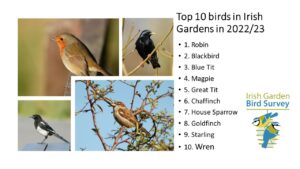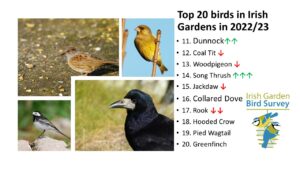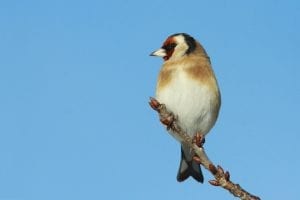Birds inject a huge amount of joy into our lives, creating the soundtrack to spring mornings and brightening up our gardens on otherwise drab winter days.
As we approach what is widely considered the “season of giving”, one surefire way to give back to the birds for all that they do for us is to participate in this year’s Irish Garden Bird Survey – the most popular and longest-running citizen science survey in Ireland.
35 years of the Irish Garden Bird Survey
Now in its 35th year, the Irish Garden Bird Survey grants people across the country the opportunity to serve as our eyes on the ground by observing and recording birds in their gardens, on school grounds, on their balconies, or within any other space they enjoy daily. All of this information gives us insight into how different species are faring and, in turn, helps us to identify current threats and future conservation priorities.

Blue Tit. Photo: Brian Burke.
The Irish Garden Bird Survey is perhaps our most simple and inclusive survey, one in which people of all ages, backgrounds and experience levels can play their part. In fact, it is so simple that, whether or not you have heard of the Irish Garden Bird Survey, it is likely that you are already doing the work.
“The Irish Garden Bird Survey is something you can do with a cup of tea looking out the window. You can do it as you’re washing the dishes or filling the kettle. People are always watching their garden birds during the winter anyway. That’s when the garden bird numbers peak. The birds are driven to gardens to look for food and people might be inside a lot more because the weather isn’t as good,” says Coordinator of the Irish Garden Bird Survey, Brian Burke. “As we always tell people, you are probably doing this anyway. We just are asking you to go that extra step by writing down and sending us what you see.”
While participating in the Irish Garden Bird Survey does not take a lot of time or effort, the impact of the data collected by participants over the past 35 years has been huge. Thanks to them, we now know that Robins, Blackbirds and Blue Tits are the most common garden bird species in Ireland. We know that species such as Great Spotted Woodpecker are on the rise. We know that the breeding Greenfinch numbers have plummeted by 48 per cent in recent years, a loss that can be almost entirely linked to trichomoniasis – a fatal disease caused by a microscopic parasite which predominantly affects finches.
2022/ 2023 Irish Garden Bird Survey Results
While there is some consistency in terms of what species are most common, cold winter weather, autumn food supplies, and the success of the summer breeding season just gone all play a part in what birds arrive in Irish gardens at this time of year.
Last year, the Robin came out on top again in Irish gardens having been seen in 99% of gardens, though were pushed to second place by the Blackbird in counties Wicklow, Offaly, Kildare and Antrim. The mild weather over the majority of last winter meant that many species were similarly widespread as in previous winters. In addition to Robin and Blackbird, Blue Tits and Magpies both occurred in over 90% of Irish gardens, while Great Tit, Chaffinch, House Sparrow and Goldfinch were in over 80% of gardens. For House Sparrow, it was their second-best year on record, likely due to a bumper breeding season. The species is on the ‘Amber list’ of Birds of Conservation Concern, so this positive trend is to be welcomed.
Though the winter weather was mostly mild, there were a few short spells of snow which drove birds into gardens in higher numbers. The first species affected by this are often the birds in the thrush family, including our resident Song Thrush and Mistle Thrush, migrant Redwing from Iceland and Fieldfare from Scandinavia.
“Despite the temperatures being mild overall, we seem to be getting more storms and multiple short snowy spells in recent years, and these can be enough to deplete birds’ fat reserves and put them under real pressure. Song Thrush occurred in an extra 12% of gardens last year owing to the snowy weather” said Burke. “So, these are the times when your garden birds really need you to provide food and water, and if you can put these out a few days before any snow hits then you’re giving the birds a chance to realise it’s there, so they know exactly where to go when the ground freezes over.”
Some very rare species were spotted in small numbers in Ireland last winter such as Bramblings, Lesser Whitethroats, Black Redstarts, Snow Buntings and Ring-necked Parakeets.
Getting involved in the survey
The value of an individual’s participation in the Irish Garden Bird Survey is not dependent on their bird knowledge, location or garden size but rather, their willingness to get involved every winter.
“The value of the survey is when people do it year after year because we can monitor the change then. It doesn’t matter if you have three species in your garden and someone else has 30, we want to find out how those three species fare over time. That is the real crux of the survey,” explains Brian. “We want to hear from people with and without feeders. We want results from every type of garden in the country so that the survey results are representative of the whole country.”
Goldfinch. Photo: Dick Coombes.
The Irish Garden Bird Survey is once again sponsored by Ballymaloe, whose support in recent years has helped ensure the survey has gone from strength to strength, improving monitoring at national level and allowing for greater focus on conservation issues facing individual species.
“United in our commitment to the environment and inspired by the legacy of our forefather, Ivan Allen, Ballymaloe businesses as a group proudly sponsor BirdWatch Ireland’s annual Irish Garden Bird Survey. Mr Ivan Allen, the husband of Myrtle Allen and a devoted lover of birdlife, cherished the natural habitat around Ballymaloe House, and practised sustainable farming way ahead of his time. In his memory, our collective support for the Irish Bird Survey reflects our ongoing celebration of Mr Allen’s passion for birdlife and commitment to conservation,” said Marketing and Digital Manager at Ballymaloe House Hotel, Helen Cuddigan.
“Together Ballymaloe House Hotel, the Ballymaloe Cookery School and Ballymaloe Foods are honoured to contribute towards supporting the preservation of Irish birdlife via BirdWatch Ireland’s important national Irish Garden Bird Survey initiative in his name. We encourage as many households as possible to get involved, every entry helps BirdWatch Ireland protect birdlife on the island of Ireland.”
Participating in the Irish Garden Bird Survey each winter is a simple and effective way of contributing to a crucial body of data that will help to guide conservation. Through taking part, you are also sure to reap many rewards as the survey offers an opportunity to increase your bird knowledge, take a daily pause and perhaps, create memorable moments with friends and family.
The Irish Garden Bird Survey will kick off on Monday, November 27th. For instructions on how to take part, see the Irish Garden Bird Survey page on our website here.





